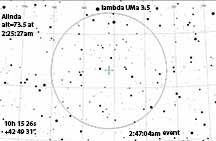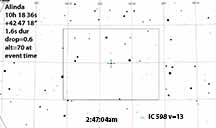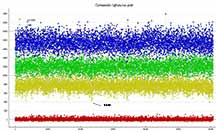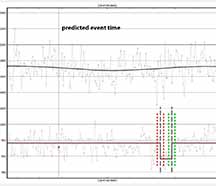

This is a favorable and easy event. Lasts 1.6s. However, the drop is only 0.45 magnitudes in R, so don't get complacent about super short integration. To see the drop clearly, I'd suggest 4x or 8x. The Target star is W=12.1 which should require 4x under good conditions. The alt=70, Az=295, so it is do-able in the standard configuration, but the altitude will be higher before the event. At 73.5 Degrees at 2:25am. So perhaps wait till closer to event time before swapping in the f/3.3 and Watec. 73.5 degrees should still clear w/ flat base, but barely. Use Lamda UMa if pointing is bad. It will be visible in the red dot finder.
In the bright pair of stars that's the Great Bear Ursa Major's paw. The lower of the pair of bright 3rd mag stars is right on the ragged edge of the Q70 eyepiece field.
The path is centered over Vick Road in BD, down through southern Scotts Valley and Happy Valley Elementary School on Branciforte is the closest drive. But I will plan to get it from Vick Road so I can get all 3 of these early morning bright occultations from the same spot.
 |
 |
Kirk did not try Alinda, nor Karl. So, alas, mine is the only record.
Good dark, clear conditions, and the target was quite easy to see at 2x, so I stayed at 2x. I set up on Vick Road, well inside the southern limit not far from the centerline of this high rank event. There's an extended period of low readings near the predicted event time. But, the light curve looks more like two short events lasting a total of 0.80 seconds (half the predicted 1.6s event full duration). I gave PyOTE the command to look for any event lasting between 4 integrations and 22 integrations, and it found the longer of the "two" events as significant, neglecting inclusion of the first event probably because it could not abide by the full return to brightness in between. Since the predicted depth is only 0.45 in R magnitudes, it's hard to say if this is:
1. A noisy miss (least likely, I believe)
2. A single event of 0.4s as found here, probably most likely
3. A binary asteroid (seems unlikely just because they are rare and the data's not good enough for such a shallow drop)
4. A binary star
5. A noisy 0.8s event
6. A 'graze' with 2 partial occultations?
Since PyOTE had the opportunity to select the whole 0.8 region as the event and did not, I'll go with choice #2 as my report and default, but with reservations, linking this page for my longer interpretation and thoughts. The false positive test was passed, with a separation between the distribution "humps" of 2.8 widths.
The event was also 4 seconds late and 0.33 mag drop. However, I note the speed of the shadow across the Earth was unusually slow. A small change in the position of the asteroid could make a large change in the observed time: moving the cursor down the shadow track, the time of the event advanced a full second in just 2km. So, that says the asteroid was about 8km or less than 2 diameters off prediction. In my experience with small asteroids, that's not that unusual, despite the nominal high rank. I'll report what PyOTE found as my default conclusion, and let the downstream users decide its fate...
magDrop report: percentDrop: 25.9 magDrop: 0.326 +/- 0.110 (0.95 ci)
DNR: 2.00
D time: [10:47:02.8460]
D: 0.6800 containment intervals: {+/- 0.0269} seconds
D: 0.9500 containment intervals: {+/- 0.1112} seconds
D: 0.9973 containment intervals: {+/- 0.2992} seconds
R time: [10:47:03.2460]
R: 0.6800 containment intervals: {+/- 0.0269} seconds
R: 0.9500 containment intervals: {+/- 0.1112} seconds
R: 0.9973 containment intervals: {+/- 0.2992} seconds
Duration (R - D): 0.4000 seconds
Duration: 0.6800 containment intervals: {+/- 0.0484} seconds
Duration: 0.9500 containment intervals: {+/- 0.1574} seconds
Duration: 0.9973 containment intervals: {+/- 0.3665} seconds
 |
 |
Two events? One event? Both interpretations possible as both are well less than the 1.6s predicted max duration of the event. |
The event was late, but by less than 2 asteroid diameters. |
 |
|
The criterion for being highly unlikely to be a false event is for the distribution centers to be at least 2 std deviations apart. They are 2.8 apart here. |
IOTA report not yet filed, because looking at GE I'm not sure where I observed from! I will recognize it if I drive up there again, and until then I will wait on filing the report. The problem is there is not 'street view' for Vick Rd after the CZU 2020 fire, and the fire made this area unrecognizable. The GE top view is post-fire, 2021, but it is not clear which dirt road I was on, until I drive there and measure my distance accurately from Empire Grade, and the nearby roads. I didn't think it would be such a problem or I'd have take more time to do so, despite being 4am by that point.